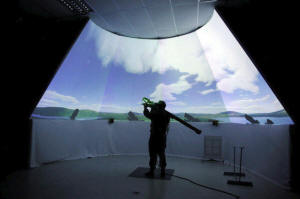|
Exclusive: Venezuela holds 5,000 Russian
surface-to-air MANPADS missiles
 Send a link to a friend
Send a link to a friend
 [May 22, 2017]
By Girish Gupta [May 22, 2017]
By Girish Gupta
CARACAS (Reuters) - Venezuela possesses
5,000 Russian-made MANPADS surface-to-air weapons, according to a
military document reviewed by Reuters, the largest known stockpile in
Latin America and a source of concern for U.S. officials amid the
country's mounting turmoil.
Venezuela's socialist government has long used the threat of an
"imperialist" invasion by the United States to justify an arms buildup.
Much of that arsenal was obtained from Russia by Venezuela's late
President Hugo Chavez, whose tenure lasted from 1999 until his death in
2013.
The missiles, which are shoulder-mounted and can be operated by one
person, pose a serious threat to commercial and military aircraft.
Weapons experts said there have long been fears that the weapons could
be stolen, sold or somehow channeled to the wrong hands, concerns
exacerbated by the current civil unrest in Venezuela and the economic
crisis roiling the oil-producing nation.
According to a Venezuelan military presentation seen by Reuters, the
South American country has 5,000 SA-24 Man-Portable Air-Defense System
(MANPADS) missiles, also known as the Igla-S.
The document seen by Reuters provides the most complete count to date of
the size of the arms stockpile. Public weapons registries confirm the
bulk of the numbers seen on the Venezuelan military presentation.
Venezuelan government and military officials did not respond to requests
for comment about the report.

COVETED BY INSURGENTS
First deployed by the United States and Soviet Union in the 1960s,
shoulder-mounted missiles have become popular with insurgent groups
around the world because they are portable, effective and relatively
easy to operate.
The U.S. for years has funded efforts to destroy MANPADS stockpiles in
unstable regions as worries have grown about the weapons getting into
the hands of militant groups. Some missiles unaccounted for in Libya
following the 2011 death of strongman Muammar Gaddafi, for example, are
believed to have made their way to other parts of the Middle East.
U.S. Central Intelligence Agency (CIA) Director Mike Pompeo expressed
concern about the Venezuelan missiles at a Senate hearing earlier this
month, though he was clear that he had no evidence that arms transfers
had taken place.
"This risk is incredibly real and serious ... to South America and
Central America in addition to just in Venezuela," Pompeo said. "The
situation in Venezuela continues to deteriorate. (Venezuelan President
Nicolas) Maduro gets more desperate by the hour."
Conservative U.S. politicians such as Florida Republican Marco Rubio
have long accused Venezuela of collaborating with a host of global
militants, including Lebanese Shi'ite group Hezbollah and Colombia's
FARC rebels, who are disbanding this year.
The Venezuelan government has long mocked such claims as lies used to
justify potential foreign aggression.
Some intelligence experts agree the allegations are exaggerated.
"The whole Hezbollah line has been distorted for political purposes by
the more extreme elements of the U.S. right wing," a former C.I.A.
senior official told Reuters.
What's certain is that Venezuela is home to a thriving illicit weapons
trade. Pistols, rifles, machine guns, even grenades are easily available
on the black market and in the country's notoriously violent prisons.
There are frequent reports of military and police officials stealing
weapons.
Colombia has in the past accused Caracas of arming guerrillas with all
manner of weaponry. Officials in neighboring Brazil have voiced concerns
that local drug gangs may be acquiring military weapons from Venezuela,
which has been rocked by seven weeks of anti-government protests.
A former Venezuelan senior army general and minister, who asked not to
be named because of the sensitivity of the information, told Reuters the
MANPADS missiles are held mainly on the coast due to government fears of
a U.S. attack.
[to top of second column] |

A Venezuelan soldier practises on an anti-aircraft artillery
simulator as part of a defensive military exercise in conjunction
with the general public in Caracas March 14, 2015. REUTERS/Carlos
Garcia Rawlins/File photo

He told Reuters that Venezuela also holds 1,500 launchers, or grip
stocks, which are fundamental to the operation of the missiles.
Venezuelan officials did not respond to a request for comment about
the location and other details of its arsenal.
U.S. WORRIES
Venezuela's MANPADS missiles, similar to the U.S. Stinger system,
were purchased towards the end of Chavez's rule.
The former paratrooper was briefly toppled in a 2002 coup endorsed
by the United States.
The U.S. denied any pretensions to meddle in Venezuela, but Chavez
warned his followers continually about the threat of American
aggression up until his death.
"We don't want war," Chavez said on TV in 2009 as dozens of soldiers
marched in front of him with camouflaged MANPADS missiles on their
shoulders. "But we need our armed forces to be ever better trained
and equipped to secure ... the sovereignty of this great nation."
Russia, a close ally, lent Venezuela $4 billion to buy weapons when
Chavez visited Moscow in 2010. It is unclear if any MANPADS missiles
were part of that deal.
The U.N. Register of Conventional Arms (UNROCA) and the Stockholm
International Peace Research Institute (SIPRI) show the shipment of
3,800 MANPADS missiles from Russia to Venezuela over the last
decade. Those records rely on voluntary reports and are often
incomplete.
In 2009, then-U.S. Secretary of State Hillary Clinton asked Russian
Foreign Minister Sergei Lavrov to stop selling MANPADS missiles to
Venezuela because of concerns over the South American country's
management of its weapons stockpiles, according to cables released
by WikiLeaks.
That same year, Colombia said Sweden's government confirmed that
three rocket launchers found in a FARC guerrilla camp in Colombia
were part of a batch that Sweden had sold to Venezuela in the 1980s.

Internal FARC documents seized by Colombia during a 2008 raid in
Ecuador appeared to show that the guerilla group entered into talks
with Venezuela to obtain MANPADS missiles, though there was no
evidence any weapons changed hands.
Venezuela did not respond to a request for comment on those
documents.
Venezuelans have taken to the streets in recent weeks to protest the
nation's collapsing economy and the Maduro government's efforts to
solidify its hold on power. Millions are struggling with severe
shortages of food, medicine and other basics.
The government blames the problems on its political opponents and
the United States.
(Twitter: @ReutersVzla, @jammastergirish; Editing by Andrew
Cawthorne, Dan Flynn and Marla Dickerson)
[© 2017 Thomson Reuters. All rights
reserved.]
Copyright 2017 Reuters. All rights reserved. This material may not be published,
broadcast, rewritten or redistributed. |